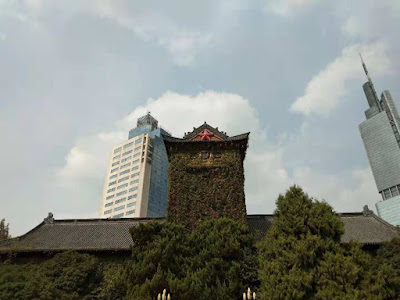Weekend in Nanjing
Hi everyone,
It seems that every post I've been writing has something to do with me never staying put! I apologize for that, but with so much beauty and history to be found, it's hard not to travel all across China!
This past weekend I went to Nanjing. It's about an hour and a half from Shanghai by speed train, and I enjoyed getting the chance to leave campus for a little bit. Sometimes the hustle and bustle of the city can leave you feeling drained and less enthusiastic about your time here, so I try and leave Shanghai every so often so that I can come back feeling refreshed.
Nanjing is home to countless important events in Chinese history. For starters, Nanjing (meaning 'southern city') used to be China's capital. Here is where you can find the tombs of the Ming Emperor, Hongwu, the founder of the Ming Dynasty himself. Interestingly enough, Chinese emperors had to pick their burial site early into their time as ruler. In this case, the emperor chose to be laid to rest in the mountainside. What makes these ruins even more special are the 12 distinct statues marking the way to his site; they ranged from guards to various animals. Animals included are: lions, camels, elephants, turtles, horses, xiezhi, and qilin. Xiezhi and Qilin are two legendary animals/beings that are only found in East Asian countries. They have a similar appearance, but their functions are different. For instance, Qilin are hooved animals that appear before the passing of a ruler, while Xiezhi had the ability to determine which party is guilty during a trial or affair. However, the overall meaning behind this is that each animal will protect the king, and each figure will guard and lead him as he enters the afterlife. If that wasn't interesting enough, keep in mind that this tomb was built in the 14th century, meaning that for 600 years this area has stood strong and remained in amazing condition. Understanding the time period can most certainly attest to the incredible craftsmanship of this time.
Another event significant to Nanjing is the Nanjing Massacre. Back in my freshmen year of college I wrote a paper on the Nanjing Massacre and talked about my questions and concerns regarding Chinese and Japanese relations. I won't go into the detail of my paper, but I wanted to spend some time sharing my experience at the memorial. This event greatly impacted Chinese and Japanese relations and, to this day, there is still some animosity towards the other country.
The difference between a memorial in America and a memorial in China is that, in America, we tend to be more reserved and "toned down", as I like to call it. However, in China, the Nanjing Memorial was extremely detailed, and very blunt. Out front of the memorial is a giant statue of a crying mother holding her dying child. If that doesn't make you aware of what you're walking into, I don't know what will.
The memorial is much larger on the inside than it looks on the outside, which is hard to believe considering everything you read and see. The Chinese did not hold back in making this memorial. Expect to see various statues, poetry depicting attacks from the perspective of the Chinese. I was amazed at how much information was portrayed, and come the end of it felt very much confused as to why events such as these are not often talked about in American schools. I won't go into the details, but I believe it is important to know this much: From December of 1937 to January of 1938 China was attacked by the Japanese in an effort to take control of China. The government ended up actually leaving the city to operate on their own, and one of the most impactful sections was the internationally organized "safe zone", something I was not aware of before this memorial. However, that aside, the mass murder, rape, and crime against the Chinese from the Japanese soldiers left the total death count at an estimated 300,000 people. There is no way to know the accurate number, but it should be known that the Japanese government has never apologized for this event and they believe the actual number is closer to 20-40,000 people. After this event, the capital was then moved to Beijing, but this does not mean that Nanjing recovered quickly. In fact, the city took decades to recover from this attack.
I did not take any pictures at this memorial due to me wanting to be as respectful as possible. I did, however, take one picture of the total death count. This number can be seen everywhere, and I felt like this was the only appropriate thing to take a picture of.
In addition to visiting such scenic sites, I also had the privilege to go to Nanjing Fuzimiao. Fuzimiao is a Confucian temple built next to the Qinhuai River. Here is where there is a scenic riverwalk, with the option to take a boat ride throughout the river. Also found here is one of the temples where Confucius was worshiped and an enshrined.
In addition to there being temples, there is also the Jiangnan Imperial Hall, where many Chinese men would take the royal examination. Those taking the exam had the potential to enter as farmers and leave as government officials; it was that serious.
Both of these locations are very near one another, and it makes for a very convenient way to appreciate Nanjing history as well as enjoy local food and culture.
 |
| Door with a red seal inviting good luck on the outside of it |
 |
| Wall art of two playing children |
 |
| Wall art of cherry blossoms |
 |
| Wall art of women with umbrella |
Also worth mentioning are some smaller activities, including visiting Nanjing University, Laomendong, and trying some local foods. If you've ever been to China, or are familiar with Chinese food, you are well aware that there is no piece of the animal that goes to waste. This weekend I got to try ducks blood, supposedly good for the heart and lungs due to the fact that it gets rid of toxins in the body. I have no idea if this is true or not, so I didn't exactly fill my bowl. I did, however, try some, so I can at least say that I've done that.
 |
| Nanjing University building |
Overall, my stay was short but the impression left on me was enough to make me want to go back. There is something alluring and inviting about a slower pace of life in China, and I couldn't help but feel sad leaving the city. Shanghai is where you would go to work, but Nanjing is where you would go and live. Does that make sense? I hope it does.
Would you ever visit Nanjing? Let me know in the comments below!
Until next time,














0 comments